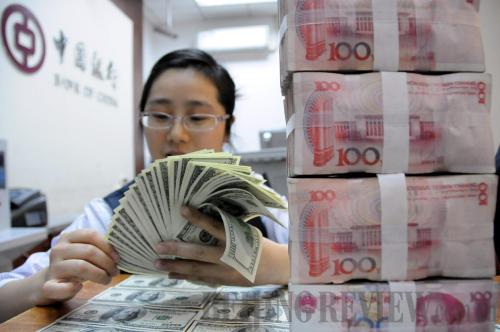|
 |
|
STACK THEM UP: A clerk counts U.S. dollar notes at a Bank of China branch in Nanchong, Sichuan Province (LI XIANGYU) |
Reform is the solution
The central bank has been focused heavily on how to effectively prevent and control financial risks to avoid a financial crisis. After the financial crisis broke out in the United States, China's financial industry has strengthened supervision to prevent risks.
According to the Financial Stability Report 2013, the major task this year is to deepen financial reform and advance the development of private financial institutions. On May 24, the State Council released guidelines to deepen economic reform, including market-oriented reform measures to liberalize interest rates and the convertibility of the yuan under the capital account. Zhao Xijun, Deputy Dean of School of Finance at Renmin University of China, says the new round of reform in China's financial sector has begun, including interest and exchange rates and convertibility.
The market-oriented reform of interest rates is to allow for better fluctuation of deposits and credit interest rates, establish a sound system for the benchmark interest rate and set up a deposit insurance system. This can better solve the risks associated with shadow banking. "The root cause for the problem of shadow banking emerging in recent years is the control of interest rates," said Zhao.
The aim of the reforms is to eventually loosen state controls on exchange rates in order to boost the country's market economy. Zhao says exchange rate fluctuation shouldn't be the focus of reform. The aim instead is to make the yuan more market-based, an important task for the Central Government this year.
As market-oriented reforms of interest rate and exchange rate are advanced, a major task of financial reforms—convertibility under the capital account—becomes increasingly urgent because it decides the process by which the yuan becomes an international currency.
According to Zhao, free convertibility under the capital account should be the last step of China's financial reform. The State Council's guideline on deepening economic reform requires that the financial supervising authority bring forward schemes for the yuan's convertibility under the capital account.
Still, fluctuation in economic growth and the possible massive outflow of capital could undermine reform plans, says Yi. "Currently the reforms are being tested, and that will test the government's resolve."
Email us at: lanxinzhen@bjreview.com
China's Financial Sector
- Banking
By the end of 2012, there had been 3,747 institutions in the banking sector, with total assets of 133.6 trillion yuan ($21.62 trillion), up by 17.9 percent; their total debts amounted to 125 trillion yuan ($20.23 trillion), an increase of 17.8 percent. Non-performing loans stood at 1.07 trillion yuan ($173.14 billion), which was 23.4 billion yuan ($3.79 billion) higher than the previous year; and the non-performing loans ratio was 1.56 percent, a decline of 0.22 percentage points from a year ago.
- Securities
By the end of 2012, there had been 1,494 domestic companies and 107 foreign-funded companies listed on China's A-share market, and 179 domestic companies listed on foreign stock exchanges. The value of the A-share market totaled 23.04 trillion yuan ($3.73 trillion). There had been 1,173 investment funds, with a total value of 866.74 billion yuan ($140.25 billion).
- Insurance
At the end of 2012, China had eight insurance holding groups, 37 domestic property insurance companies, 21 foreign-funded property insurance companies, 22 domestic life insurance companies and 25 foreign-funded life insurance companies. In 2012, the premium income totaled 1.55 trillion yuan ($250.81 billion), and the compensation expenses amounted to 471.63 billion yuan ($76.32 billion).
(Sources: China Banking Regulatory Commission, China Securities Regulatory Commission and China Insurance Regulatory Commission) | 